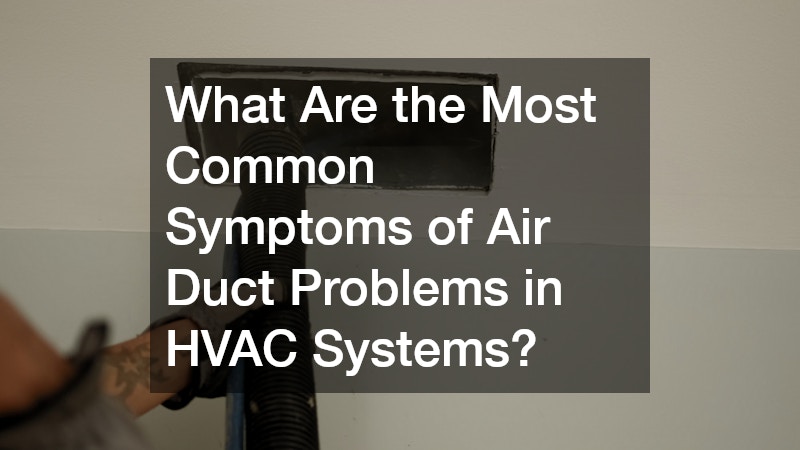

An efficient HVAC system is a cornerstone of comfort in modern homes and workplaces. Yet, many people do not realize that the air ducts within these systems play an equally crucial role in ensuring overall functionality and efficiency. Understanding the common symptoms of air duct problems is vital for maintaining a healthy indoor environment and avoiding unnecessary energy costs. This article aims to shine a light on the most prevalent signs indicating air duct issues in HVAC systems.
By recognizing these symptoms early, homeowners and facility managers can take timely action to mitigate potential problems.
Visible Signs of Wear and Tear
One of the most apparent indicators of air duct problems in HVAC systems is visible wear and tear on the ducts themselves. This can include peeling insulation, rust, or structural damage to the ductwork, all of which contribute to inefficiencies in air delivery. When these signs are evident, it’s a clear indication that the ducts may not be functioning optimally. These physical deformities can lead to air leaks, reducing the system’s ability to maintain desired temperatures. Over time, this inefficiency not only increases energy bills but also puts undue stress on the HVAC system.
Another visible symptom is the accumulation of dust and debris around the vent openings. This build-up is not merely an aesthetic issue but indicates underlying problems that need attention. Dusty air ducts can circulate allergens and pollutants throughout the property, adversely affecting indoor air quality. Property owners noticing excess dust around vents should investigate further, as this could be a symptom of clogged or dirty ducts. Regular inspection and cleaning of air ducts can help prevent these issues from becoming severe.
Inconsistent Airflow and Temperature Distribution
HVAC systems rely on balanced airflow to properly condition interior spaces. A common symptom of air duct problems is inconsistent airflow throughout different rooms. When some areas are significantly warmer or cooler than others, it may suggest that ductwork is blocked or leaking. These inconsistencies often result in discomfort for occupants and inefficient system operation. Ensuring that air flows evenly throughout the property helps improve both comfort and system efficiency.
Temperature discrepancies can also point to more underlying issues beyond uncomfortable conditions. Uneven temperature distribution could mean that heat or cooled air is escaping through gaps or poorly sealed ducts. This detracts from the HVAC system’s efficiency, leading to increased energy consumption and elevated utility bills. Addressing any leaks or blockages within the ductwork can aid in achieving uniform temperatures throughout the property. Engaging professionals to inspect and seal ducts might be necessary to resolve these issues.
In addition to airflow issues, unusual noises like whistling or humming might also be detected from the ductwork. These sounds typically indicate internal blockages or deteriorations such as tears or disconnections within the duct system. Ignoring these auditory clues may lead to more significant problems, including reduced air quality and further damage to the HVAC unit. Regular maintenance checks can help identify and rectify these problems early on. An efficient and quiet system is usually a sign of well-maintained air ducts.
Elevated Energy Bills
A sudden rise in energy bills is often one of the more financially straining indicators of air duct problems in HVAC systems. When air ducts are compromised, they force the HVAC system to work harder to maintain the desired temperatures, thus consuming more energy. This inefficiency can significantly elevate monthly utility costs, putting a financial burden on property owners. By recognizing the correlation between duct issues and increased energy usage, owners can take steps to rectify the situation. An energy audit could prove beneficial in pinpointing the exact source of inefficiency, whether it be duct-related or symptomatic of other system components.
Restriction of airflow due to clogs or improperly sized ducts can also contribute to higher energy consumption. When airflow is impeded, the HVAC system strains to circulate air, thus consuming additional power in its operation. The resulting increase in energy use is a reliable symptom of duct issues needing investigation. Proper maintenance and addressing duct size and integrity can ensure improved system performance and reduced energy waste. Aligning ductwork with the system’s capacity can enhance operational efficiency greatly.
Poor Indoor Air Quality
Indoor air quality is directly affected by the condition of air ducts in an HVAC system. The most common symptoms of air duct problems often manifest as deteriorated air quality, which can impact the health and wellbeing of occupants. Pollutants, allergens, and contaminants circulating due to inefficient ducts can lead to respiratory issues and other health complications. As indoor air quality declines, so does the comfort level within the living space. Regular cleaning and maintenance of ductwork are essential practices for ensuring healthier indoor air.
The presence of unusual odors could also be linked to compromised air ducts. Stagnant air, mold, and mildew can develop within the ductwork, releasing odors that permeate through the system into living areas. If not addressed, these conditions not only spread unpleasant smells but also pose health hazards to occupants. Regular professional inspections and cleanings can help alleviate these issues and restore air quality. Maintaining fresh and odor-free air is a significant aspect of a comfortable indoor environment.
Identifying the common symptoms of air duct problems in HVAC systems is crucial for maintaining a healthy and efficient indoor environment. Visible signs like wear and tear, inconsistent airflow, elevated energy costs, and poor indoor air quality are all indicative of potential duct issues. Regular inspections, audits, and maintenance can help address these problems before they escalate into more costly repairs. Homeowners and facility managers should prioritize duct maintenance to ensure optimal system performance. By taking proactive steps, we can extend our HVAC systems’ longevity while guaranteeing a comfortable and energy-efficient indoor climate.
.



